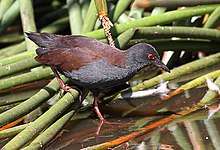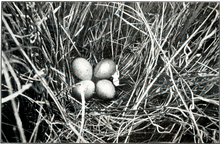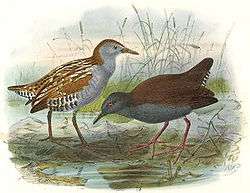Spotless crake
| Spotless crake | |
|---|---|
 | |
| Coolart Wetlands, Mornington Peninsula, Victoria, Australia | |
| Scientific classification | |
| Kingdom: | Animalia |
| Phylum: | Chordata |
| Class: | Aves |
| Order: | Gruiformes |
| Family: | Rallidae |
| Genus: | Porzana |
| Species: | P. tabuensis |
| Binomial name | |
| Porzana tabuensis (Gmelin, 1789) | |
| Synonyms | |
|
Zapornia tabuensis | |
The spotless crake (Porzana tabuensis) is a species of bird in the rail family, Rallidae. It is found in American Samoa, Australia, the Cook Islands, Fiji, French Polynesia, Indonesia, Melanesia, Micronesia, New Zealand, Niue, Papua New Guinea, the Philippines, Pitcairn, Samoa, Solomon Islands, and Tonga.
Description
Adult
As an adult the spotless crake can reach a length of 17 – 20 cm; a wingspan of 26 – 29 cm; and can weigh between 40 – 50g. The head, and neck of the spotless crake is a bluish–grey slate colour. Some also have an occasional light grey or whitish patch on the chin, which can extend down the throat. The back, the outer wings, and inner wings have a dark reddish–brown which then fades into a dark blackish – brown on the tail feathers. The underside of the spotless crake is also a bluish–grey which then transitions to a blackish–grey on the underside of the tail feathers. Its bill is black, and its eyes are a deep red which contrast sharply with the head. The legs and feet are a reddish–pink colour.[2] Spotless crake lack any obvious sexual dimorphism, making it hard to distinguish between male and female.[3] .
Juvenile
The juvenile spotless crake is similar to the adult, but its colouring is duller over the whole body, and is paler and browner than the mature crake. Its chin and throat have a white patch on it. The back is a dull brown, and the head and underside is a dull grey–brown. The eyes are a brownish-orange which then begin to turn red as it matures. The colour of the legs and feet can vary from an olive–brown, brownish–grey, or a brownish–flesh colour which also turn red as it matures.[2]
Voice
The spotless crake has a variety of calls, although little is known about the meaning of each. Originally, seven separate calls of the spotless crake were detected, including a bubbling sound, a sharp, high pitched ‘pit-pit’, a ‘mook’ sound which varies in loudness and pitch, and a loud ‘purring’ call.[4] The high-pitched ‘purr’ sound is believed to be its song. This call is made up of a rapid series of notes which are roughly 25 per second, making it its loudest call.[3] More calls were detected at the time but since then only four have been described.[5]
Eggs
The colour of spotless crake eggs are a ‘dull creamy brown or pinkish with faint chestnut flecks’.[5]
Distribution and habitat
Natural global range
The spotless crake naturally occurs in many countries throughout the south pacific. These countries include: ‘Philippines, Moluccas, New Guinea, Melanesia, Australia, Tasmania, Norfolk Island, and south-west Polynesia including New Zealand’,[6] as well as Indonesia.[2]
New Zealand range
In New Zealand, the spotless crake, also known as pūweto, is distributed throughout the mainland. Numbers are few in the South Island with only a handful of isolated communities on the west coast, east coast, and Southland, New Zealand. The distribution in the North Island is spread far wider, but there are still few communities. Most sightings of spotless crake tend to be near the top of the North Island.[7] Nationally important sites include: Awarua-Waituna wetland complex in Southland, New Zealand, Great Barrier Island, Kermadec Islands, Lake Wairarapa, Poor Knights Islands, Tiritiri Matangi Island, and Whangamarino wetland in Waikato.[8]
Other than the mainland the spotless crake has been found on many offshore islands including: ‘Kermadec Islands, Manawatäwhi/ Three Kings Island, Poor Knights Island, and the Chatham Islands’. Fossils of the spotless crake from the Holocene period have also been found on the mainland, as well as the Chatham Islands.[6]
Because the spotless crake is rarely seen, it is hard to determine what the population size is, so currently population numbers are unknown in New Zealand.[8]
It is believed that the reason spotless crake are rarely found in the South Island, New Zealand is due to the more dominant rail the marsh crake pushing the spotless crake out of suitable habitat, as the natural habitat of the two species are very similar. Another reason may be that they are not as tolerant of the colder climate due to them being more common in high altitude wetlands.[9]
Habitat preferences
Spotless crakes are freshwater wetland birds. Their preferred habitat is wetland and swamp areas that contain dense vegetation in which to build their nests from.[4] They can be found foraging on open muddy areas near dense vegetation, but when disturbed they retreat back into the vegetation. On some small offshore islands, where wetlands are sparse, they have been known to live and forage in dry forest.[8] Although raupo tends to be the preferred habitat for spotless crake, they have also been found in swamp areas composed of flax (Phormium tenax), tussock sedge (Carex secta), and cabbage tree (Cordyline australis).[3] If habitat is not ideal, they are also able to migrate locally, which other subspecies do elsewhere.[8]
Life Cycle/Phenology
Length of time to reach maturity
When the chicks hatch, they stay in the nest for up to four days, and have the ability to catch live prey from three days old. Chicks are then reared by both the male and female for 4 – 5 months.[8]
Description of mating
Determining the sexual behaviour of spotless crake is difficult due to their shy nature and dense vegetation which restricts observations. Kaufmann [3] observed the mating of spotless crakes at Pukepuke Lagoon where the make and female circled a patch of tussock sedge (C. secta) then stood on it. The female arched her body with the bill facing down. The male then mounted, while balancing with outstretched wings. Intromission only lasted a few seconds.
Description of egg laying
Time of year and length of incubation

Spotless crake nests are made up of interwoven grasses within patches of tussock sedge and raupo.[8][3] They usually breed in large, dense, and tall stands of reeds, rushes, sedges, and grass tussocks.[2] Their nests are found between 30 – 50 cm above the water, and are found to be in close proximity to other nest-like platforms.[3][5] Eggs are lain from late August to the end of January, with a clutch size of between 2 and 5 eggs. Both the male and female incubate the eggs for between 20 – 22 days.[8][3][3] It is believed there is evidence to suggest that clutch size increases as the season progresses; from 3 egg clutches in August and September to 5 egg clutches in December. Hadden [4] found the same pattern in clutch size.
Diet and Predators
Diet
Spotless crake are omnivorous. Their diet consists of seeds, fruits, shoots of grasses, leaves of aquatic plants, adult and larval insects, mollusks, crustaceans, spiders, carrion, worms, beetles, and other insects.[2][5][8]
Predators
Due to the introduction of mammalian predators, the spotless crake is vulnerable to predation. Predators include cats, dogs, mustelids, and rats. The major predator threat appear to be cats.[8] Parents may feign injury to distract predators if they are present.[5]
Other Threats
Other threats to spotless crake are the clearance of habitat, such as swamp draining and clearing for agriculture which mainly took place when Europeans arrived. Water pollution and degradation of wetlands due to grazing are also major threats.[8]
Other Information

References
- ↑ BirdLife International (2012). "Zapornia tabuensis ". IUCN Red List of Threatened Species. Version 2013.2. International Union for Conservation of Nature. Retrieved 26 November 2013.
- 1 2 3 4 5 Marchant, S.; Higgins, P. J., eds. (1993). Handbook of Australian, New Zealand, and Antarctic Birds. Volume 2, raptors to lapwings. Melbourne: Oxford University Press.
- 1 2 3 4 5 6 7 8 Kaufmann, G; Lavers, R (1987). "Observations of breeding behaviour of spotless crake (Porzana tabuensis) and marsh crake (P. pusilla) at Pukepuke Lagoon" (PDF). Notornis. 37: 193–205.
- 1 2 3 Hadden, D (1970). "Notes on the spotless crake in the Waingaro District". Notornis. 17 (3): 200–213.
- 1 2 3 4 5 Fitzgerald, N (2013). "Spotless crake". New Zealand Birds Online – The digital encyclopaedia of New Zealand birds. Retrieved 12 April 2017.
- 1 2 Gill, B. J; Bell, B. D; Chambers, G. K; Medway, D. G; Palma, R. L; Scofield, R. P; Tennyson, A. J. D; Worthy, T. H (2010). Checklist of the birds of New Zealand, Norfolk and Macquarie Islands, and the Ross Dependency, Antarctica. New Zealand: Te Papa Press.
- ↑ Robertson, C. J. R; Hyvonen, P; Fraser, M. J; Pickard, C. R (2007). Atlas of bird distribution in New Zealand, 1999-2004. New Zealand: Ornithological Society of New Zealand.
- 1 2 3 4 5 6 7 8 9 10 "Spotless crake/ puweto". Department of Conservation. Retrieved 13 April 2017.
- ↑ O'Donnell, C. F. J (1993). "Canterbury". Notornis. 41 (3): 211–213.
| Wikimedia Commons has media related to Porzana tabuensis. |
| Wikispecies has information related to Porzana tabuensis |
